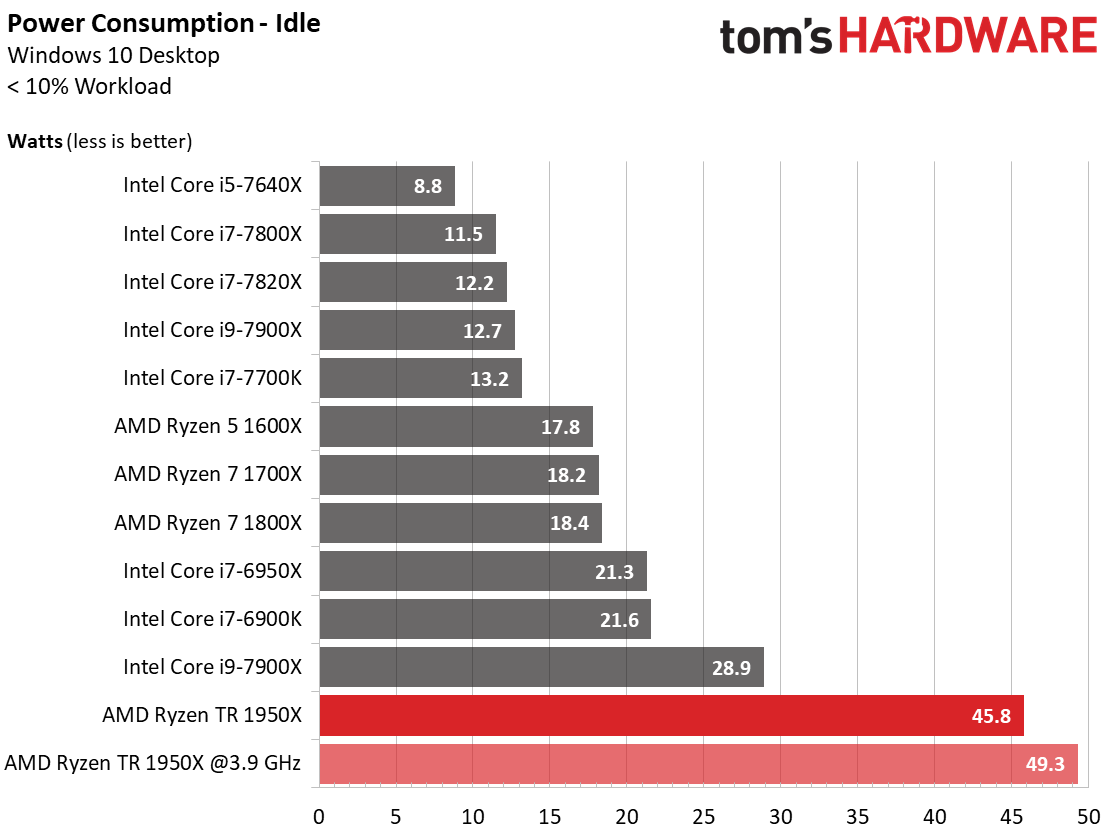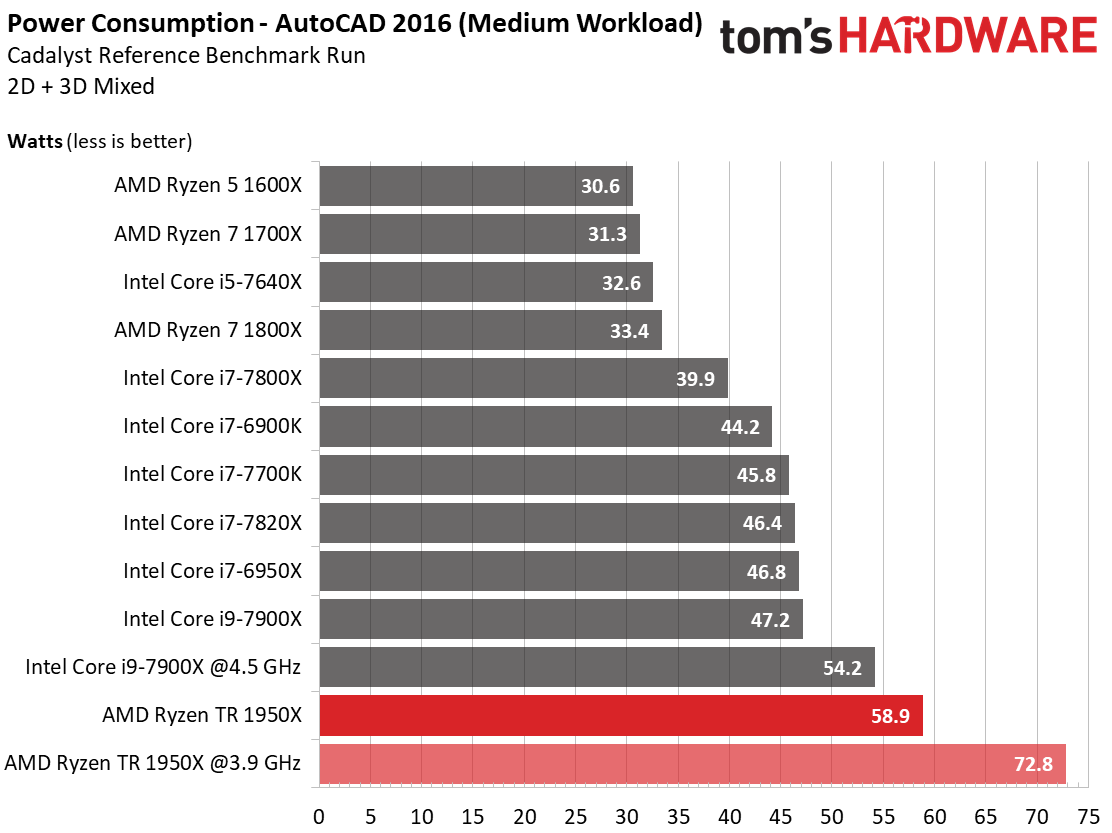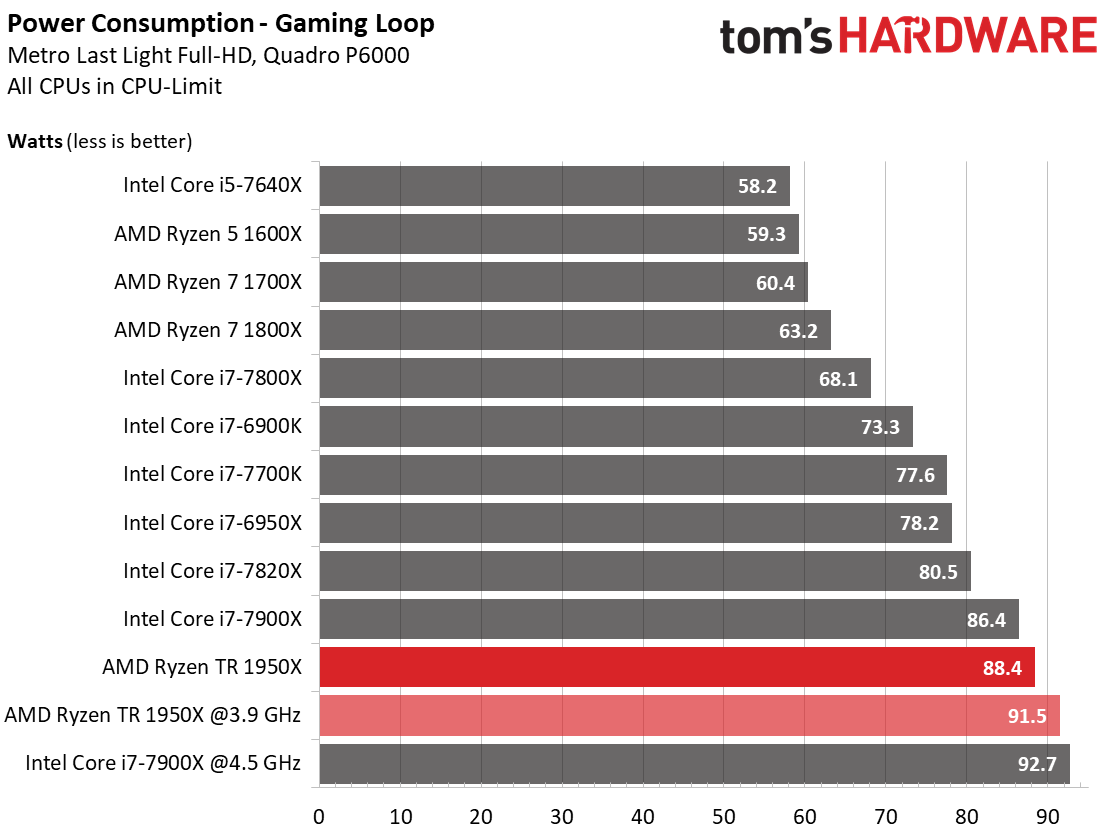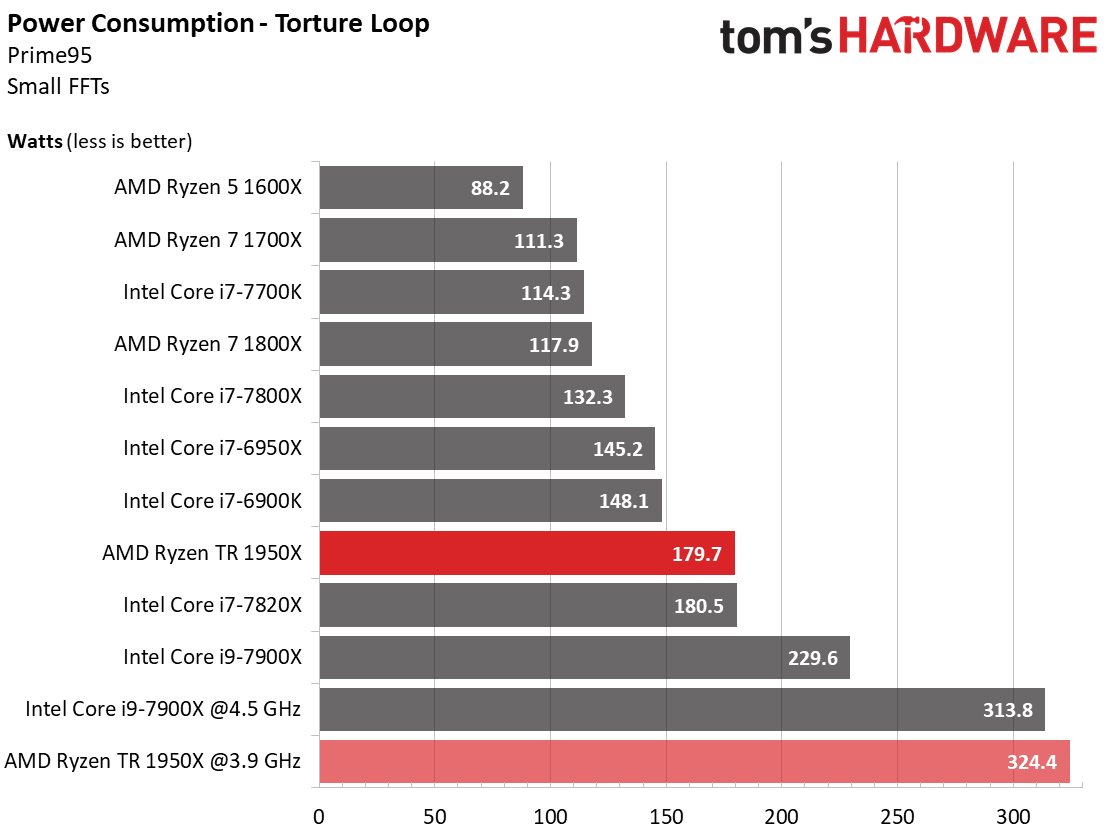AMD Ryzen Threadripper 1950X Review
Why you can trust Tom's Hardware
Power Consumption
We establish the package’s power consumption results by using a special sensor loop. This way, our values represent the exact amount of power that goes into the CPU and then reemerges in the form of power loss, which is to say waste heat dissipated by the cooling subsystem. We check our sensor readings using shunts and measuring overall power consumption directly at the EPS connector (current probe and direct voltage measurement).
The CPU values supplied by the voltage converters on the motherboard via HWinfo64 are sufficiently precise for our purposes, even though the measurement intervals are longer than those of our oscilloscope. We retested Intel’s Core i9-7900X after overclocking it to 4.5 GHz and added its results to the graphs to provide a fair comparison.
We need to note that AMD’s Threadripper CPUs use different partial voltages for the SOC and SMU rails at different clock rates. These partial voltages, which, again, depend on the frequency, do have an influence on the overall package’s power consumption results. AMD recommended that we use the profile included with their 32GB DDR4-3200 kit. If the memory was operated using the standard SPD values for DDR4-2133, then the power consumption would be 15W lower!Both of AMD’s CPUs are designed for a maximum power consumption of 180W at their default settings. If the memory’s overclocked, then the CPU gets 15W less, which might affect performance in usage scenarios that employ all of the cores and, consequently, get too close to the limit.
Idle Power Consumption
Compared to AMD’s Ryzen 7, the Threadripper’s idle power consumption is just over twice as high. However, Threadripper also hosts two dies instead of one, and it also hits higher clock rates under occasional loads. The overclocked version utilizes higher voltages as well, and we just mentioned the memory’s role in power consumption.
CAD Workload Power Consumption
AutoCAD 2016 rarely uses more than two or three cores for its usual tasks. In fact, most of the time it's limited to a single core. Thus, it's not surprising that the CAD power consumption only adds a maximum of 15W to the idle power numbers, especially since the latter’s not truly idle power consumption to begin with.
The two overclocked versions add another 14W, which makes for an almost 30W difference compared to the idle power consumption. And then there’s the memory, of course.
Gaming Power Consumption
When it comes to gaming, we see an issue where Threadripper’s many cores get in each others' way. Consequently, overall performance ends up lackluster. The power consumption’s on the same level as that of Intel’s Core i9-7900X, even though Skylake-X fares much better in the benchmarks. The results are similar to those we reported for the real-time 3D CAD benchmarks.
Get Tom's Hardware's best news and in-depth reviews, straight to your inbox.
Stress Test & Maximum Power Consumption
Power consumption goes through the roof during our stress test. This is especially true for the overclocked configurations.
In the case of a stock Intel Core i9-7900X, the motherboard has to shoulder some of the blame for this. It doesn’t lower the processor’s clock rate in accordance with the rules, but leaves them at a much higher level.
AMD’s Ryzen Threadripper doesn’t have those kinds of issues. The Asus X399 ROG Zenith Extreme motherboard limits power consumption to exactly 180W, just as it should, when using the default settings. Things look a whole lot different once the processor is manually overclocked to maximize its frequency, though. The 1950X needs 1.35V to achieve 3.9 GHz. At that point, AMD's new processors join Intel's overclocked Core i9-7900X well beyond 300W.
Bottom Line
Depending on the task, Threadripper's two dies sometimes consume more power than other processors’ single dies. This is to be expected when all cores are operating at full load. The high power consumption’s okay if it’s put in the context of correspondingly high application performance, as long as the work that’s being done has been parallelized well and the software is optimized for AMD's architecture.
Unfortunately, Threadripper's efficiency during gaming turns out to be significantly worse than Intel’s. Skylake enjoys notably higher IPC, after all. A large portion of Threadripper's higher power consumption comes simply from a baseline that notches up from Ryzen 7. Even at idle, it draws an additional 15W or so. If those 15W are subtracted from Threadripper's gaming power consumption, then the results look a lot better. It brings their lower power consumption increase compared to idle in line with their lower gaming performance.
MORE: Best CPUs
MORE: Intel & AMD Processor Hierarchy
MORE: All CPUs Content
Current page: Power Consumption
Prev Page Overclocking, Cooling & Temperature Next Page Final Analysis
Paul Alcorn is the Editor-in-Chief for Tom's Hardware US. He also writes news and reviews on CPUs, storage, and enterprise hardware.
-
I just looked at gaming benchmark and stopped reading there because as i thought Intel CPUs are killing Thread Ripper in gaming. As far as content creation, naturally having 16/32 setup will be faster than Intel 10/20 but again do you really need more than 10/20 cores. I don't and i heavily use PC for gaming, programming, web design, video/audio encoding. Overall Intel 7900x is better value and all around CPU. But if you are just in gaming 7700k is just enough.Reply
Thanks for review, and hello x299 platform.
Gaming vs. Content Creation mode through Software is just another big NO NO to me knowing how crappy AMD software is. I assume the most people will keep it in Game Mode and leave it as it is.
I appreciate that AMD brought this CPU for $999 with so many cores, helps competition but again there is nothing to drool over here in my book. AMD didn't bring any significant performance bump core vs. core basis. In fact AMD single core performance still sucks which means when Intel releases 10+ core CPU it is going to fun to watch.
Two things i am interested the most is Coffee Lake product and IPC improvement there and possible price adjustment with Core i9.
-
Kai Dowin I'm truly impressed to see 16 Zen cores consuming as much power as only 10 Skylake-X ones. Bravo, AMD!Reply -
Reply20045233 said:I'm truly impressed to see 16 Zen cores consuming as much power as only 10 Skylake-X ones. Bravo, AMD!
I am not knowing that Intel is running higher frequency.
-
JamesSneed Reply20045197 said:I just looked at gaming benchmark and stopped reading there because as i thought Intel CPUs are killing Thread Ripper in gaming. As far as content creation, naturally having 16/32 setup will be faster than Intel 10/20 but again do you really need more than 10/20 cores. I don't and i heavily use PC for gaming, programming, web design, video/audio encoding. Overall Intel 7900x is better value and all around CPU. But if you are just in gaming 7700k is just enough.
Thanks for review, and hello x299 platform.
Gaming vs. Content Creation mode through Software is just another big NO NO to me knowing how crappy AMD software is.
I love Intel even more...all you have to do pop CPU in and shit works and it works well.
I guess if gaming is why you were reading the Threadripper review then you are right it isn't as good as Intel's offerings but did you honestly expect any other result? I don't know why reviewers even do gaming tests on any CPU over 8 cores as it is mostly pointless. If you are doing scientific, encoding, professional tasks in just about every use case that is multi threaded it is blowing away every Intel offering. Of course that may change once there are 12-18 core Intel parts. However spending $1000 for a CPU is a bargain for those than can use it and never in history could you get a 16 core consumer part with this type of multi-threaded performance.
-
Lyden Thank you for this review. I was seriously considering Threadripper. Looks like the 7700k is still the sensible choice for the price when gaming.Reply -
Kai Dowin @FREAK777POWER And delivering higher multi-threaded performance with these lower clocked cores. Do you know what that's called? Efficiency.Reply -
redgarl This chip is designed for heavy calculation multithreading, it is not made for gaming, however it is working well with 1440p and 2160p.Reply
By the way, who in their mind will buy a 16 core CPU and play at 1080p with a 1080 TI... seriously, these 1080p bench are a joke and don't represent reality...
"A standard or point of reference against which things may be compared." Oxford
1080p with 1080 TI with a 16 core processor is not a point of reference at all. -
Pompompaihn Who are you people that come here and <ModEdit> about gaming performance on these chips??Reply
Threadripper is the F250 of CPUs. It's not the fastest, but it's plenty fast for 99% of your tasks, and if you need to haul a 12,000 pound trailer it'll do that, too. This is for people who do a lot of WORK on their machine but also game on the side.
<Moderator Warning: Watch your language in these forums>



